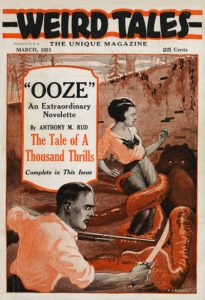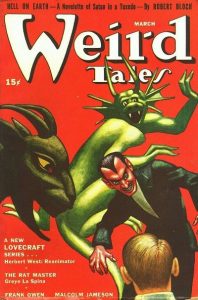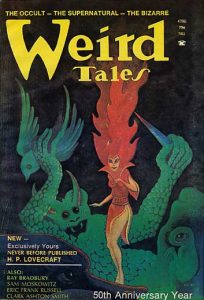 Almost one-hundred and twenty-five years ago, on August 20, 1880, Howard Phillips Lovecraft was born in Providence, Rhode Island. According to the late Robert Bloch, author of PSYCHO, Lovecraft was, “A precocious child, he learned to read when he was four and soon experimented with writing. Poor health kept him from college and economic necessity eventually caused him to neglect amateur journalism in favor of ghostwriting or revising the work of others for professional publication. Gradually he began to produce poetry and fiction of his own.” His “career as a professional writer was largely compressed into a span of about sixteen years. He remained virtually unknown except to the limited readership of pulp magazines such as WEIRD TALES in which his work appeared. It earned only a pitiful pittance to supplement the income from a meager inheritance, and he continued his anonymous chores for other writers.”
Almost one-hundred and twenty-five years ago, on August 20, 1880, Howard Phillips Lovecraft was born in Providence, Rhode Island. According to the late Robert Bloch, author of PSYCHO, Lovecraft was, “A precocious child, he learned to read when he was four and soon experimented with writing. Poor health kept him from college and economic necessity eventually caused him to neglect amateur journalism in favor of ghostwriting or revising the work of others for professional publication. Gradually he began to produce poetry and fiction of his own.” His “career as a professional writer was largely compressed into a span of about sixteen years. He remained virtually unknown except to the limited readership of pulp magazines such as WEIRD TALES in which his work appeared. It earned only a pitiful pittance to supplement the income from a meager inheritance, and he continued his anonymous chores for other writers.”
Bloch continues: “Today Lovecraft is established as a major American fantasy writer, frequently ranked as the equal of Poe. His work is in print here and abroad and the mild-mannered, old-fashioned, conservative New England gentleman has become an acknowledged master of horror fiction.” What then should be made of this magazine that earned “The Copernicus of the horror story,” as author Fritz Leiber described Lovecraft, “a pitiful pittance to supplement the income from a meager inheritance?”
WEIRD TALES was the first periodical to be largely devoted to the fantasy genre. Premiering in early 1923, its publishers envisioned “The Unique Magazine” as a place for a writer to be given “free rein to express his innermost feelings in a manner befitting great literature.” It began to come into its own in late 1924 after Farnsworth Wright was named the magazine’s editor. In the years ahead, the pulp would become known for its fantasy and supernatural fiction, publishing the work of Lovecraft, Robert E. Howard, and Clark Ashton Smith. Other substantial writers included Bloch, E. Hoffmann Price, Carl Jacobi, Henry Kuttner, Frank Belknap Long, C. L. Moore, Seabury Quinn, Manly Wade Wellman, Henry S. Whitehead, and others. WEIRD TALES would also become noted for its artists: Hannes Bok, Margaret Brundage, J. Allen St. John, and Virgil Finlay all contributed tremendously to the fantasy art field through their work for “The Unique Magazine.”
In addition to publishing some of the best fantasy and supernatural fiction of the twentieth century, WEIRD TALES, like the Munsey magazines, featured science fiction in its pages, offering tales of interplanetary expeditions, brain transference, death rays, lost races, parallel worlds, and more. Edmond Hamilton was its leading contributor of science fiction. With stories about alien invasions, space police, and evolution gone wild, the author became known as “world-wrecker” Hamilton. Other notable science fiction authors to appear in WEIRD TALES were Ray Cummings, Austin Hall, Otis Adelbert Kline, Moore, Donald Wandrei, and Jack Williamson. In his later years, H. P. Lovecraft spun his own style of science fiction in his tales of cosmic horror.
 The original run of WEIRD TALES began with its March 1923 number, with Edwin Baird as the editor, and ran through its September 1954 issue, for a total of 279 issues. During this period, it was perhaps the most important and influential of all fantasy magazines, providing an outlet for stories that probably would not have been published elsewhere. This was especially true during the Wright years when it published many of Lovecraft’s most influential works; introduced the sword-and-sorcery genre through Robert E. Howard’s stories of Kull, Solomon Kane, Bran Mak Morn, and Conan; shared Clark Ashton Smith’s wonderfully evocative stories of Hyperboria, Averoigne, and Zothique; and featured the early work of artists Hannes Bok, Margaret Brundage, and Virgil Finlay. As pulp scholar Robert Weinberg has written, “It was in WEIRD TALES . . . that traditions were broken . . . . that unusual writing and poetry was featured. The outrageous and the ordinary mingled side by side in the magazine . . . It was a magazine where anything might find a home.”
The original run of WEIRD TALES began with its March 1923 number, with Edwin Baird as the editor, and ran through its September 1954 issue, for a total of 279 issues. During this period, it was perhaps the most important and influential of all fantasy magazines, providing an outlet for stories that probably would not have been published elsewhere. This was especially true during the Wright years when it published many of Lovecraft’s most influential works; introduced the sword-and-sorcery genre through Robert E. Howard’s stories of Kull, Solomon Kane, Bran Mak Morn, and Conan; shared Clark Ashton Smith’s wonderfully evocative stories of Hyperboria, Averoigne, and Zothique; and featured the early work of artists Hannes Bok, Margaret Brundage, and Virgil Finlay. As pulp scholar Robert Weinberg has written, “It was in WEIRD TALES . . . that traditions were broken . . . . that unusual writing and poetry was featured. The outrageous and the ordinary mingled side by side in the magazine . . . It was a magazine where anything might find a home.”
Although Wright did indeed publish some rather substantial stories during his editorship — including Lovecraft’s “The Call of Cthulhu,” “The Whisperer in Darkness,” and “The Haunter of the Dark;” Howard’s “The Tower of the Elephant,” “A Witch Shall Be Born,” “Pigeons from Hell,” and “Red Nails;” C. L. Moore’s “Schambleau” and Jirel stories; Clark Ashton Smith’s “A Rendezvous in Averoigne,” “The Vaults of Yoh-Vombis,” and “Genius Loci;” Henry S. Whitehead’s “Jumbee,” and many others — he was, at the same time, rejecting a great deal of fine work. H. P. Lovecraft was told that “At the Mountains of Madness,” was “too long,” “not easily divisible into parts,” and “not convincing.” “The Shadow over Innsmouth” was rejected for similar reasons. Both have since become recognized as classics. In a letter addressed to Lee Alexander Stone in 1930, Lovecraft wrote: “Henry S. Whitehead . . . says that Wright uniformly rejects his best stories. Very like Wright — whose bland dumbness transcends my utmost limits of comprehension.” In a letter to Richard Searight, written in 1935, Lovecraft summarized his feelings about Wright by stating, “His capricious editorial policy does give me a large-sized cervical pain! He has consistently turned down my best work . . . on the ground of length, while at the same time taking far longer things (for the most part utter tripe) from others. It is clear to me that he does not like my work, no matter what he says to the contrary.”
Howard, Smith, and others experienced similar rejections. In a letter mailed to Wright about a year before his tragic suicide, Robert E. Howard stated, “WEIRD TALES owes me over eight hundred dollars for stories already published and supposed to be paid for on publication — enough to pay all my debts and get back on my feet again.” Some scholars have suggested that Wright’s sometimes difficult stance taken with his best writers may have contributed to the early deaths of Howard and Lovecraft and the premature end of Smith’s writing career.
As part of its celebration of the 125th anniversary of the birth of H. P. Lovecraft, PulpFest 2015 is proud to welcome Don Herron, editor of the scholarly landmark, THE DARK BARBARIAN, and winner of the 2006 Black Circle Award for lifetime achievement in Robert E. Howard studies; Morgan Holmes, longtime member of the Robert E. Howard United Press Association and a book review editor for THE DARK MAN; Professor Tom Krabacher of California State University, Sacramento and a member of the Pulp Era Amateur Press Association; 1979 Lamont Award winner and author of “The Wild Adventures of Doc Savage and Tarzan” Will Murray; and popular culture Professor Garyn G. Roberts, who was awarded the Munsey in 2013, for a presentation entitled “Weird Editing at ‘The Unique Magazine’.” Scheduled for Saturday evening, August 15th, at 7:55 PM, our panelists will discuss the editorial policies of WEIRD TALES, concentrating particularly on the reign of Farnsworth Wright.
Join PulpFest 2015 at the beautiful Hyatt Regency in downtown Columbus, Ohio, beginning on Thursday, August 13th and running through Sunday, August 16th, for a salute to H. P. Lovecraft and WEIRD TALES, just a few short days before the author’s 125th birthday. Although our host hotel is completely booked, there are still some rooms available at nearby hotels. Please visit our Facebook page at www.facebook.com/PulpFest and click on the post pinned to the top of the page. You’ll be directed to a list of hotels to choose from. If you are not from the Columbus area and want to attend PulpFest 2015, we urge to book your room now and not later. Rooms that are relatively close to PulpFest are disappearing fast during the time frame of our convention.
(The first issue of WEIRD TALES, dated March 1923 with a cover illustration by R. R. Epperly, is best remembered for publishing Anthony M. Rud’s “Ooze,” a story concerning a giant amoeba. Also featured in the issue were tales by Otis Adelbert Kline, Joel Townsley Rogers, R. T. M. Scott, and Harold Ward. The issue was put together by Edwin Baird, the editor of the magazine until the November 1924 issue, when Wright took the helm.
Hannes Bok created seven covers for WEIRD TALES. The last appeared on the issue dated March 1942. It was edited by Dorothy McIlwraith, who succeeded Farnsworth Wright following the March 1940 number. McIlwraith would publish Ray Bradbury’s first professional solo story, “The Candle,” in the November 1942 issue. She also helped to launch the careers of author Fritz Leiber and fantasy artist Lee Brown Coye.
 Almost two decades after its original demise, WEIRD TALES was revived in 1973-1974 for four issues, edited by Sam Moskowitz. The second issue, from the fall of 1973, featured cover art by Gary van der Steur after Hannes Bok’s cover from March 1940. A paperback series lasting four more issues, edited by Lin Carter, appeared from 1981-1983. The magazine was revived in 1988 by George H. Scithers, Darrell Schweitzer and John Gregory Betancourt and has, more or less, been published on a continuous basis since that time. in 2014, the 362nd issue was released. It is currently published by John Harlacher with Marvin Kaye serving as editor. For more details, visit the magazine’s website at http://weirdtalesmagazine.com/.)
Almost two decades after its original demise, WEIRD TALES was revived in 1973-1974 for four issues, edited by Sam Moskowitz. The second issue, from the fall of 1973, featured cover art by Gary van der Steur after Hannes Bok’s cover from March 1940. A paperback series lasting four more issues, edited by Lin Carter, appeared from 1981-1983. The magazine was revived in 1988 by George H. Scithers, Darrell Schweitzer and John Gregory Betancourt and has, more or less, been published on a continuous basis since that time. in 2014, the 362nd issue was released. It is currently published by John Harlacher with Marvin Kaye serving as editor. For more details, visit the magazine’s website at http://weirdtalesmagazine.com/.)






